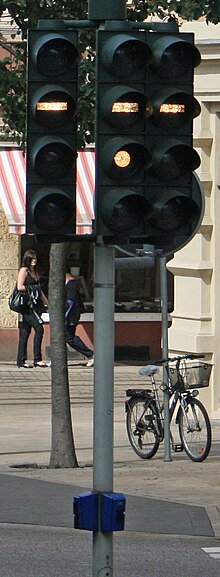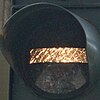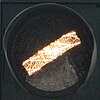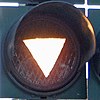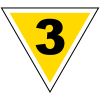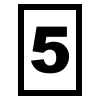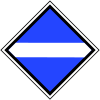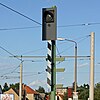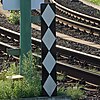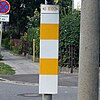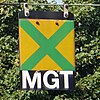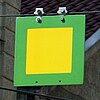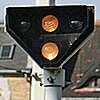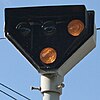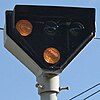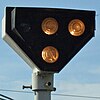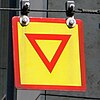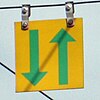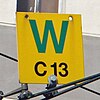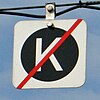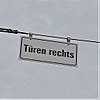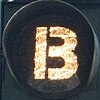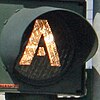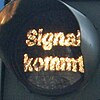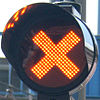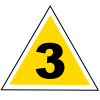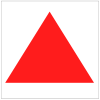Tram signals in Germany
The tram signals in Germany are based on the tram construction and operating regulations (BOStrab). The driving signals (F 0 to F 5) are so-called bar signals , which also apply to some other public transport vehicles . There are also bar signals in many other countries. The following is a selection of the valid signals according to BOStrab including the "old" signals of the new federal states that are still valid according to the local service regulations for driving traffic (DF) as well as regionally valid signals. Some of the signals shown here are also used for trolleybuses (in addition to the bar signals, the signals St 1 to St 7 and G 2a). If there are regional deviations from the BOStrab , these are expressly permitted (Section 65 (3) BOStrab), provided the technical supervisory authority has not requested or requested a change in the respective case.
Main and distant signals
Main signals and distant signals are used on route sections with train protection. They are only intended as light signals and, like the advance signals, which the BOStrab calls "advance warning signals", correspond to the railroad's H / V signaling system . They can be supplemented with speed signals G 1 and G 2 in the same way.
| Abbreviation | meaning | description | image |
|---|---|---|---|
| H 0 | Stop | a red light | |
| H 1 | journey | a green light | |
| H 2 | Driving with a speed limit | a green over a yellow light | |
| V 0 | A stop is to be expected at the following main signal | two yellow lights rising to the right | |
| V 1 | Driving is to be expected at the following main signal | two green lights rising to the right | |
| V 2 | At the following main signal, travel with speed restrictions is to be expected |
a green and a yellow light increasing more rapidly from left to right |
In many companies, however, other forms also occur due to technical developments. A typical case is multi-section signaling with yellow on the main signals and matching distant signals with only one yellow and one green light.
| Abbreviation | meaning | description | image |
|---|---|---|---|
| (Hp 3) | A stop is to be expected at the following main signal | a yellow light |
On train protection routes in classic street and light rail networks, pre-signaling is often dispensed with because of the better braking capacity compared to rail vehicles. Main signals are often supplemented by mast signs, which regulate the behavior in the event of a malfunction. However, apart from the sloping black and white striped location identifier So 3 and the white, yellow, white, yellow and white mast sign So 4, they are not included in the BOStrab. The white, red and white mast signs known from railway companies are often used.
Driving signals when driving on sight
| Abbreviation | meaning | Picture or description |
|---|---|---|
| F 0 | Stop | |
| F 1 | Drive released only straight ahead | |
| F 2 | Drive released only to the right | |
| F 3 | Drive released only to the left | |
| F 4 | Stop expected (locally according to the respective DFStrab also: release or stop expected ) |
|
| F 5 (permissive signal) | Drive released in compliance with the turning rules in accordance with § 9 StVO |
Driving signals are grouped together in signal screens with one to four lanterns. There is a separate signal transmitter for each direction of travel, i.e. up to three next to each other. In the figure at the top right, the signal system can show the following signals (from top to bottom): on the left “Signal is coming”, F 0, F 4, F 3; Middle “signal comes”, F 0, F 4, F 1; and on the right “Signal comes”, F 0, F 4, F 2. It shows stop for all directions and expect free travel for the straight ahead direction.
If buses or trolleybuses for local public transport use routes that are separated from public roads, there are also driving signals F 0 to F 5 for buses. The signals for buses and trams are often marked by additional signs in accordance with Section 39 of the StVO.
The upper picture shows from left to right: first signal "Halt" (F 0), in the middle the combination of "Halt" (F 0) and underneath "Expect halt" (F 4) not provided in the SOStrab, on the right again "Halt “(F 0). The middle representation is assessed locally (for example according to the DFStrab of HAVAG in Halle (Saale) with a different meaning for F 4) as an announcement for a signal F 2, F 3 or F 5 (analogous to the "red-yellow" of the StVO) , would, however, be legally a “nonsense representation” of “stop” and “expect stop” based on the current status of BOStrab .
The picture below shows from left to right: first signal for the bus straight ahead: "Signal comes", F 5; second signal for straight trams: "Signal is coming", F 0, F 4, F 1; third signal for bus turning right: "Signal coming", F 5; fourth signal for trams turning right: "Signal is coming", F 0, F 4, F 2. In the illustration, the signaling system for trams currently shows stop for straight ahead and expect stop for right-turns.
Clearance signals
| Abbreviation | meaning | Picture or description |
|---|---|---|
| A 1 | close the door | |
| A 2b | Depart |
Signal A 1 can be white or yellow, signal A 2b white or green.
Speed signals
| Abbreviation | meaning | Picture or description |
|---|---|---|
| G 1a | Announcement of the speed limit | |
| G 2a | Start of the speed limit | |
| G 2b | ||
| G 3 | End of the speed limit | |
| G 4 | Change of the permissible speed upwards (replaces G 3 together with G 2a) |
The code number on the speed signals must be multiplied by ten. Then, analogous to the railway, you get the permissible speed in kilometers per hour. In some cases the speed is displayed in full, for example as 20 for 20 km / h. There are also displays that tell public transport drivers the optimal speed, e.g. B. how fast he / she has to / can drive so that, after stopping at the stop, he does not prevent the next trip from going to the stop by standing at the traffic light and blocking the stop.
Protection signals
| Abbreviation | designation | meaning | Picture or description |
|---|---|---|---|
| Sh 1 | Forced stop | Stop here in any case when driving on sight |
|
| Sh 2 | Protective stop | No further travel is permitted | |
| Sh 3a | Emergency stop | stop in the shortest possible way | at least three short acoustic signals in quick succession |
| Sh 3b | white-red-white flag or arm moved in a circle |
||
| Sh 3c | Light (preferably red) or luminous object in the circle moves |
||
| Sh 3d | flashing red light or several red lights one below the other |
||
| Sh 4 | Ring | give acoustic warning signals | |
| Sh 5 | Caution | acoustic warning signal to warn people |
moderately long tone or chime |
| Sh 6 | Boundary sign | Limit up to which the track may be occupied when the tracks converge |
|
| Sh 7 | Stop board | Place where the head of the train should stop |
Can also be represented with a black H on a white background. |
Switching signals
| Abbreviation | designation | meaning | Picture or description |
|---|---|---|---|
| St 1 | Signal contact | Signal contact is to be actuated | |
| St 2 | Switch contact | Switch contact is to be operated | |
| St 3 | Turn off | From the signal St 3 on, the traction current must be switched off | |
| St 4 | Switching on allowed | The traction current may be switched on from the signal St 4 | |
| St 5 | Remove pantograph | The current collector must be removed from the signal St 5 onwards | |
| St 6 | Put on pantograph | From the signal St 6 onwards, the pantograph may be applied again | |
| St 7 | Line separator | The traction current must be switched off briefly | |
| St 8 | Stop for vehicles with pantograph applied |
Vehicles with pantographs are not permitted to travel beyond Signal St 8 |
In the case of modern systems, St 1 and St. 2 usually no longer about (contact line) contacts, but about sensors of a different kind. The signals St 3 to 6 and 8 correspond in appearance and meaning to the contact line signals El 1, 2 and 4 to 6 of the German railway signal book .
Turnout signals
| Abbreviation | meaning | Picture or description |
|---|---|---|
| W. 1 | Switch stands for straight travel with a maximum of 15 km / h |
|
| W. 2 | Turnout stands for travel to the right with a maximum of 15 km / h |
|
| W. 3 | Turnout stands for travel to the left with a maximum of 15 km / h |
|
| W. 11 | Switch stands for driving straight ahead at the permitted speed |
|
| W. 12 | Switch stands for travel to the right at the permitted speed |
|
| W. 13 | Switch stands for travel to the left at the permitted speed |
|
| W. 14th | Switches must not be opened |
The symbols are mostly yellow, white is also allowed. W. 14 is only available as a white on black board.
A turnout signaling system shows the directions for each turnout. One to four signal lamps are arranged one below the other. In the figure above right, it can be shown from top to bottom: W 0, W 11, W 13 and W 12. In this case, the signal system applies to two points in a row. This shows that the train that can be seen on the left is blocking the turnout in the position to the left. The turnout cannot be changed by any other train at the moment. In addition, the switch can be driven at the full intended speed. If, for example, two turnouts can point to the left in a row, this can also be shown with two signals next to each other (see picture on the right). The difference between W 1, W 2 and W 3 on the one hand and W 11, W 12 and W 13, on the other hand, consists in the fact that the tongue device in the respective end position in the first case is only fixed with a force fit (switch without lock), but in the second case with a positive fit (the switch is locked).
Monitoring signals for level crossings
| Abbreviation | designation | meaning | Picture or description |
|---|---|---|---|
| Bü 0 | Signal does not light up | Stop in front of the level crossing - continue according to the traffic situation |
|
| Bü 1 | Signal flashes white | Level crossing may be used | |
| Bü 2 | Level crossing announcement | Expect monitoring signal |
Special signals
| Abbreviation | designation | meaning | Picture or description |
|---|---|---|---|
| So 1 | Start of a route with train protection | Transition from driving on sight to driving on train protection |
a square board with two black dots on top of each other |
| Sun 2 | End of a route with train protection | Transition from driving on train protection to driving on sight |
a square board with two black dots on top of each other and a red diagonal stripe rising to the right |
| Sun 3 | Location identifier | indicates the location of a main signal | |
| Sun 4 | Order sign | Drive past the stop signal on special instruction | |
| Sun 5 | No encounter at the beginning | You may only continue to drive if the opposite track is free. The ban on encounters can be restricted by additional signs for certain directions or vehicles. (here: in Halle Saale only applies to meter-gauge articulated railcars of types MGT6D and MGT-K ) |
|
| Sun 6 | No encounter end | The ban on encounters ends at this point. Sign can be omitted if the end of a bottleneck is obvious. |
The special signal So 5 can also use an additional signal to identify the route to which the sign applies. In the case of the illustration above, only two trains turning left are prohibited. Since this is not a longer route, there is, as an exception, no end signal So 6.
Old signals with local validity
These signals remain locally valid, are partially replaced by the signals after the BOStrab and often apply in parallel to the new signals.
| Abbreviation | meaning | Picture or description |
|---|---|---|
| old St 6 | Stop | |
| old St 7 (new): We 1 | Drive straight ahead | |
| old St 8 (new): We 2 | Drive freely to the right | |
| old St 9 (new): We 3 | Drive freely to the left | |
| old St 10 | Drive straight ahead and to the right | |
| old st 11 | Drive straight ahead and to the left | |
| old st 23 | Another train must be given right of way | |
| old st 24 | Right of way over another train | |
| old St 29 | bus stop | |
| old St 29a | Double stop | |
| old St 36 | Point at which the encounter with a counter train is allowed |
The meaning of the signals St 7 to 11 corresponds to the driving signals F 0 to 4, with other combinations such as "free to the right and left" being possible.
Regional signals
Depending on the local conditions, there are signals that are only valid regionally.
| image | meaning | |
|---|---|---|
| Turnout number (only in Halle (Saale) and Dresden ) | ||
| Note the right of way according to the StVO | ||
| End of contact path; in Halle (Saale) according to the local DFStrab end of the coordinated release | ||
| Duisburg, Essen, Munich: A contact request has become effective | ||
| Doors on the right, stop after the turnaround in Halle (Saale) with the two-way vehicle MGT-K | ||
| Signal influence (public transport priority), locally also "track occupied" Stuttgart trams : Zs 11, operating status indicator, it is under the signals that can be meaningfully darkened during operating hours. In Halle (Saale) according to the local DFStrab operational regulation (the signal has different meanings depending on the installation location) According to DFStrab St 9b |
||
| Stuttgart trams: advance signal, allows advance to the next signal | ||
| Stuttgart trams: H5 follow-up signal, allows you to drive into a stop at speeds of up to 30 km / h, for example if a train is leaving there | ||
| Stuttgart trams : H4 caution signal, allows you to continue driving at speeds of up to 20 km / h to the next main signal, buffer stop, stationary train | ||
| Tram in Heidelberg and Mannheim : "M" magnetic contact. The "M" means that the vehicle magnet (coupling coil) of a railcar is located above a request loop. After pressing a switch button, the signal is requested and the "A" (registration) appears, partly in the same signal head. | ||
| Essen, Krefeld: message receiver - carriage is above the coupling coil - press switch button here | ||
| Tram Heidelberg : "WF" means turning trip. It is set up in Heidelberg at Bismarckplatz and means that the railcar does not drive into the stump track to turn , but turns on the regular track. | ||
| logged on to signal system. u. a. in Halle (Saale), Bochum, Essen and Mülheim (Ruhr) wait for the connection (contrary to the timetable; also for the bus / tram transition). |
||
| Travel signal is coming soon | ||
| Always free travel even when the traffic light shows a stop (red) (permanent F1 as a signal board) | ||
| Switches that have to be reset - Switches must be reset in the indicated direction immediately after driving | ||
| Start of a curve lubrication system | ||
| Permissible speed at the next prominent point (e.g. switch, stop). E-sign (G 3) is omitted. | ||
| Expect F0 for the next travel signal | ||
| Expect F1 at the next driving signal | ||
| W0: Turnout is being driven over and cannot be changed. F6: Turnout system / signal system disrupted |
||
| Karlsruhe tram : Sun 11 - single-track section occupied by a return train | ||
|
Hanover tram, slow speed point (G 5)
A triangular yellow plaque on one side with a white border and black numbers. The Zugspitze may pass signal G 5 at the specified maximum speed. |
||
|
Hanover tram, limited emergency stop (Sh 3e)
The train must be stopped in front of the platform with a service brake, if necessary with an emergency brake. The signal is in front of the platform in the direction of travel. |
||
|
Hanover tram, give way (Sh 9)
An equilateral white triangle on top. Identifies the point at which the right of way of another rail vehicle must be observed. |
||
|
Hannover tram, note the maximum value indicator (Sun 7)
A white, square board with a red triangle pointing upwards. This signal can be used to increase the maximum permissible speed in the train protection system. |
||
|
Hanover tram, speed limit ride and on sight (train protection) (H 3)
One green and two yellow lights |
See also
Web links
- Text of the tram building and operating regulations
- Collection of all BOStrab issues ( Memento from November 5, 2014 in the Internet Archive )
- http://www.wedebruch.de/gesetze/persbef/bostrab3.htm#anl4
Individual evidence
- ↑ a b c d Stuttgart Tram World , information board
- ^ A b Bogestra AG : SO Strab, Annex 5 to DF Strab ", as of July 2004
